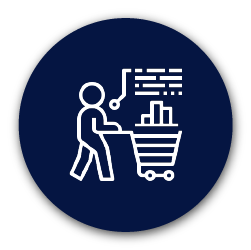When it comes to sharing and analysing sales data, it's a well-known fact that retailers like to keep things close to their chest. You don't want to share it. It makes sense, especially if you consider this information as proprietary data. Why would you want to risk having that data getting in the wrong hands? There are many things that could go wrong. But what can happen if it goes right?
What if you decide to share your data with the right people? With your vendors and manufacturers? Not only does it build trust but it can lead to benefits for you both.
For one thing, you might have some data about the products that your suppliers might not have. Meanwhile, your suppliers might have insights into the products that you don’t have. By pooling your knowledge and expertise, you can expect to make better assortment and product offering choices, which leads to more sales.
Of course, you first need to understand the data types that you can get from either side.
In this article, we will be looking at both retailer and supplier data, the roles they play, and the positives and negatives that come with each data type.
 Buyer Data: What Retail Buyers rely on
Buyer Data: What Retail Buyers rely on
To understand the specific data and its importance, that retailers and their buyers rely on, it’s worth first unpacking the definition of retail data:
Retail data refers to any facts or figures that you can collect about your retail business which can then be used to improve your business.
While the above definition simplifies the fundamental essence of retail data, there’s a little more to it. This data can come in many different shapes and forms, including point of sales data, loyalty card data, and market data - to name but a few.
Retailers also rely on various key performance indicators, measures and types of data when it comes to retail, namely;
1. Competitor data
Retail buyers use competitor data to inform their decisions based on their competitors’ sales performance per brand. This allows them to develop a strategic approach to their next steps to ensure they deliver the best tactics going forward.
By knowing the market, identifying it, and analysing competitor data, retail buyers can make informed decisions as to which products to stock and determine the most optimal quantities of inventory for different products within the environment. This will prevent under or overstocking and will ensure a good customer experience.
Those are not the only positives of using competitor data. It also includes:
- Having insights into your competitor’s sales performance provides the necessary information the retailer needs, to be the first choice of product purchases;
- Allowing you to be more proactive in terms of future approaches regarding sales and promotions;
- Being able to navigate possible obstacles for future product launches;
- Identifying gaps in the market;
- Helping determine how you can enhance your own business; and
- Leveraging strengths and identifying weaknesses.
There are, of course, risks and uncertainties associated with using this data too. When considering these data types, retail buyers must remember that:
- It can cause hindrances in terms of kicking off new product launches, due to the risk of it clashing with competitors’ simultaneous new product launches. This may result in some consumers choosing the competitor’s product instead of owned products;
- It can misinterpret the uniqueness of your offerings; and
- It won’t necessarily satisfy the needs of those in the market.
For retailers, it’s also worth pointing out that gaining access to competitor data can be a prohibitively expensive exercise and budget constraints may limit your ability to do so.
2. New Product Development (NPD)
Retail buyers also rely on New Product Development data (NPDs), which can generate an influx of profit for retailers as it is new to the market and consumers tend to purchase new products more often to test them on themselves. Once consumers have a positive experience, they will purchase more and, through word-of-mouth, communicate to those around them, which ultimately increases sales.
New Product Development data may also assist retailers in making informed decisions based on how the sales of the NPDs indicate whether consumers of a specific retailer are purchasing the products or not. This indicates which store clusters should or should not get the new products.
For example, if an NPD for Generalist hair care is planogrammed in an Ethnic store cluster, it will not earn the sales it would, compared to when it is planogrammed in a majority Generalist hair care store cluster.
Here are a few positives of using new product development data:
- It can indicate which store profiles will purchase the NPD and generate the most sales.
- It can determine which stores are likely to encounter out-of-stocks faster than others. These stores might need more stock than others, to prevent out of stock issues.
- It can help you manage and measure success
- It can help you identify new target markets
As with most things in retail - and life - where positives exist, there are almost always also negatives that you need to be aware of. They include:
- That NPD data will only be helpful within a few months after launch. Some consumers are sceptical about purchasing new products (brands) which they haven't personally used before. They will rather wait a few months to hear about other consumers' reviews, before trying it out;
- NPD sales data takes longer to accumulate and might only show promise within a few months of launch;
- There are extra costs related to new product development; and
- You would need to delist current ranges to make space for new products on-shelf.
3. Sales and Units
When a product sells out within a few days, it’s a good indication that consumers like the product and will most likely purchase it more often. These products will receive more facings on the shelf as they naturally will have a low days of supply characteristic.
Sales and units also indicate which products are not performing well in terms of sales and unit growth. These SKUs are then considered for discontinuation due to poor performance.
Sales and units data can provide crucial insights into what is happening in the market.
For example, it can indicate if there is a sales growth or decline in the market and how it compares to units. You can also identify trends that can help you manage ranges and make range changes to reflect the numbers.
Are you looking for more reasons why sales and units data are worth looking at?
Sales and units data can:
- Help you to focus on the SKUs which can improve, by, for example, increasing the number of facings;
- Help you to know which SKUs have the potential to increase sales;
- Show how the removal of one SKU can mean opening up on best-performing SKUs or by adding NPDs;
- You have the opportunity to improve your decisions;
- You can reduce your costs by preventing over or understocking; and
- You can Improve the customer shopping experience.
On the negative side, you do need to watch out for a few things. These include:
- Possible product removal from shelves down the road, due to poor performance;
- Potential Fraud; and
- Questionable data quality and capturing.
 Supply Chain Data: What suppliers offer retailers
Supply Chain Data: What suppliers offer retailers
As with the beginning section on retail data, before we unpack supply chain data or supplier data, it’s worth defining what it is.
Supplier data includes critical information such as the details of the point of contact at the company, Location/geographical information and the goods and products each vendor supplies.
So what type of data can you expect from the supply chain and suppliers?
1. Sales and Units
Providing retailers with sales and unit data helps suppliers justify and motivate their reasons for the space they are requesting on the shelf.
It also helps to build a mutually-beneficial relationship between the retailer and their suppliers, which is critical for any successful collaboration.
The data being provided here can help to:
- Determine opportunity gaps;
- Improve stock management; and
- Cut down on extra costs.
As a supplier, you want to help retailers whilst helping yourselves. Providing this data to retailers (the same goes for retailers sharing their data with suppliers, by the way) can also show retailers new and more effective ways to grow a category.
For example, Product A sells 15% more if it is placed next to Product B as opposed to Product C. This could provide useful information to a retailer - information they do not yet have, haven’t asked for, but that you’re willing to provide. Relationship-building 101.
2. Historical data (for forecasting)
Historical data is the study of market behaviour over a given period. The characteristics of good quality historical data are:
- Accuracy;
- Completeness;
- Reliability;
- Relevance; and
- Timeliness.
So why is it a good idea for suppliers to provide historical data to retail buyers and retailers in general?
For one, the flow of information on product inventory and sales usually goes one way: from retailer to supplier.
Suppliers often provide retailers with service-level reports, but these reports can be manipulated easily, don't show the impact on the shopper, and do not improve shelf availability. Suppliers need to empower their own decision-making with data systems that can provide insights into sales.
In today's retail supply chain, both suppliers and retailers must harness the power of the cloud and the capability of advanced business analytics to deliver deeper insights and enable data-driven decision-making.
With flow-of-goods analytics, suppliers can decrease waste while increasing availability, ensure they meet shopper demands, achieve granular insights from the factory to point of sale, better prepare for unplanned events, and develop robust business relationships with retail partners.
Here are a few more reasons to provide historical data:
- It allows suppliers to track seasonal trends;
- You can analyse past purchasing behaviours and
- You can provide better insight on pricing and promotions.
Suppliers must be careful though because there are risks associated with this.
For example, some retailers only provide a 12-month data set in total, due to their trading terms. Thus obtaining more historical data has cost implications for the supplier.
3. Opportunity Gaps
A gap analysis exercise allows a supplier to spot any shortcomings that can and must be overcome. It can be easier to quantify or identify these gaps to assist with any future improvements, thereby improving the efficiency of both the retail and supplier business. It also allows suppliers to pinpoint anything unusual.
Not only will it benefit a supplier to determine these opportunity gaps, but doing so also helps out the retailer.
Retailers can use their resources wisely, and profits can be increased by determining what is happening now and what could happen if these opportunity gaps were filled.
It is important that when analysing data, opportunity gaps are taken into consideration, as they may determine consumer buying behaviour and patterns.
If a supplier provides a retailer with this information, they are showing retailers that they are not only focused on the success of their business but also on that of their retail partners.
Also, opportunity gaps do not only lead to increased profits. More customers will visit the retailer’s stores to enjoy the richer experience they are now offering. It also allows suppliers and retailers to collaborate at a deeper level in creating a shopping experience that meets the needs, wants and demands of the shoppers. Because, at the end of the day, the retailer’s shoppers are the supplier’s customers too.
Finding the opportunity gaps also helps both the retailer and supplier to better understand their intended target market.
Conclusion
As you have seen, the sharing of data is mutually beneficial for both retailers and suppliers. You only need to consider the benefits to understand that not sharing data is harmful to your future business. These benefits are clear for both retailers and suppliers:
- Better decision making,
- Identifying of opportunities,
- Improved Merchandising Layouts,
- Understanding trends in data patterns and
- Increased profits.
Looking at just some of the key metrics like sales and unit data, gap opportunities and New Product Developments opens the door for many more metrics and KPIs to analyse to understand the importance of retailer and supplier data. And that’s just the beginning of what can be a fruitful retailer-supplier relationship.
About the contributors
Maryka Fourie joined DotActiv in 2021 as a space planner, working to deliver data-driven planograms to L’Oréal. She has a Bachelor of Consumer Science (Honours) from the North-West University.
Sanmari Roberts joined DotActiv in 2021 as a space planner and works on various ad-hoc accounts, including Premier Foods, Danone and Dr. Oetker. She has a BPhil (Honours) in Marketing Management from the IMM Graduate School.
Siphesihle Ndlozi joined DotActiv at the end of 2019 and has worked on several accounts including Liquor City and Dis-Chem. She is currently a space planner at Adcock Ingram. She completed her Bachelor of Arts in Fashion at LISOF (now known as STADIO).
Yolandé Beumer joined DotActiv in May 2019 as a retail space planner for Edible Groceries at Pick n Pay before moving to Dis-Chem. In 2021, she was promoted to account manager where she will look after various ad-hoc accounts. She has a BSc in Consumer Science with Business Management from the North-West University and recently graduated with her Masters.


